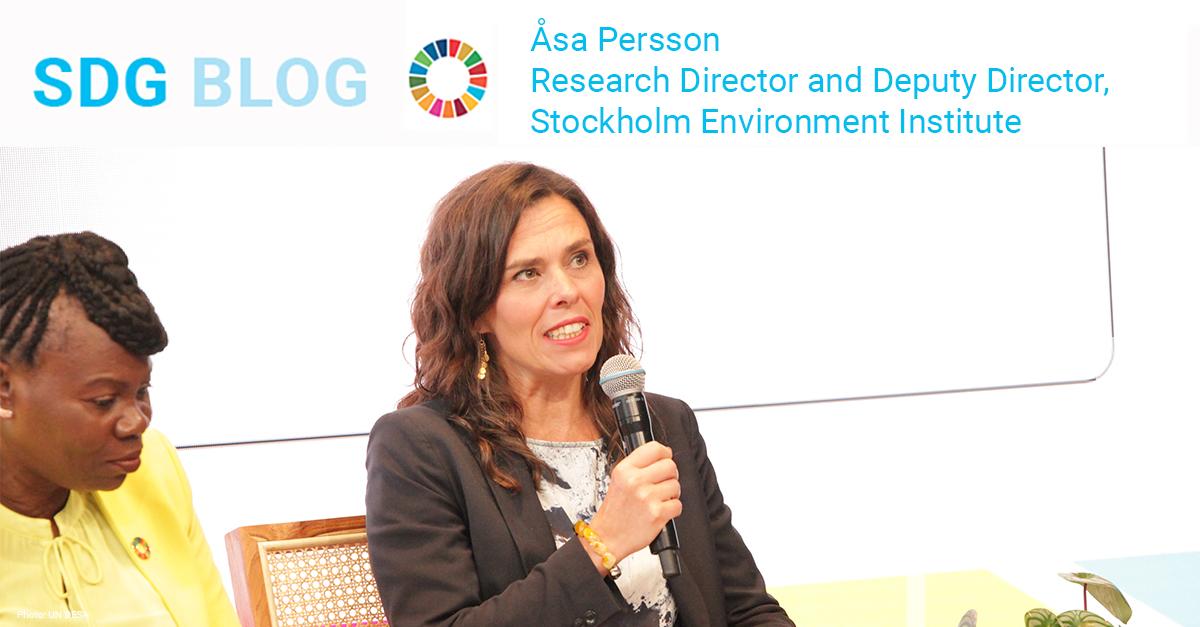SDG Blog

Using the GSDR to guide a credible and effective second half of the 2030 Agenda
By Åsa Persson, Research Director and Deputy Director of Stockholm Environment Institute and member of the Independent Group of Scientists that prepared the 2023 Global Sustainable Development Report
Transformation is possible, and inevitable.
This was the key message of the 2023 Global Sustainable Development Report (GSDR) that we in the Independent Group of Scientists presented to Member States gathering at the United Nations for the Sustainable Development Goals (SDG) Summit in New York last month. Did it resonate? It remains to be seen. World leaders did agree to take transformative action in the SDG Summit political declaration – “We commit to bold, ambitious, accelerated, just and transformative actions, anchored in international solidarity and effective cooperation at all levels” – but, as with any international summit, words must be put into action. And that only happens after summits – in government budget negotiations on fuel tax rates, in corporate board rooms adopting supply chain sustainability standards, in city halls deciding to invest in girls’ education programmes, in community meetings consulting on sanitation facilities, and so on.
As scientists, we landed on this simple, yet complex key message after careful review of evidence, substantial discussion in our group and many consultations with diverse stakeholders. Numerous scientific synthesis reports over the last decade have concluded that transformation is needed to adequately respond to the sustainability challenges we now face. For this report, we sought to advance the synthesis: Is transformation not only needed, but can we also say it is possible?
From scientific evidence and historical examples, we now know that large-scale transformations can be actively triggered and shaped, and we have a good idea which tools and levers can be used at what stage of the process. At the same time, evidence also suggests that change is inevitable – whether it relates to the near-term climate change impacts we unfortunately can anticipate with current emission trends or to benefitting from the global renewables race. The key question is really whether societies are passively transforming, likely away from the SDGs, or are they actively managing their own transformation pathways, moving closer to the SDGs?
To help countries move towards this second option, the GSDR provides concrete advice on how they can be proactive about these transformation pathways. First, in the report, we document what shifts and interventions are required to transform our energy and food systems, ensure human well-being, and so on. Through science and policy experience, we have a good idea what they are, for example, carbon pricing, universal health coverage, increased investment in agricultural R&D. However, some management of expectations is needed here. Our group of 15 scholars has no magical quick fix or any simple game-changing intervention to offer. Reforms of this kind instead require structured, persistent analytical work, the building of broad coalitions and the design of robust policy mixes, to ensure a supportive political economy and to avoid backlash.
Second, our report identifies distinct capacities for steering transformations. Governments, institutions and networks need to upskill on strategic planning: What sequencing and mixes of interventions are needed, to scale and accelerate action and to overcome foreseeable impediments? Enhanced foresight can help us think beyond immediate challenges. In a changing world, how can decision-makers effectively pool intelligence and think beyond the term in office and beyond 2030? Another key capacity of likely growing demand is to constructively negotiate and resolve goal conflicts. New methods for public engagement, developed in research and policy practice, are available.
Third, the wide scope of the 2030 Agenda and the 17 SDGs required the GSDR to engage with a corresponding breadth of science. It was particularly encouraging to see how the SDG framework has inspired new distinct research fields that have developed fast. Reviewing the scientific literature on SDG interlinkages, we could establish that there appear to be more synergies than trade-offs between the goals. Moreover, there are several practical tools available for Member States and other actors to use themselves or in partnership with researchers to identify and quantify positive and negative interlinkages, in order to manage them. Another emerging research field relates to the international spillovers from SDG action.
Overall, it was an absolute privilege to be part of the Independent Group of Scientists and develop the GSDR in consultation with so many experts, stakeholders, and peer reviewers. It is rare for us scientists to have such a direct communication channel to the UN General Assembly and it will be even more exciting to contribute to regional and national dissemination of the report, to work with others as we inspire action, road-test and learn.
As much as we need to cherish the unparalleled uniting force and common language that the SDGs uniquely offer in a fragmented world, I believe we also need to approach the second half of the 2030 Agenda in a clear-eyed, honest and credible way. This means drilling deep into why we are off-track on specific targets, before jumping to solutions. This means being honest with people about trade-offs and goal conflicts – many of which are short-term, rather than long-term – and involve them in the resolution. And this means evolving from static snapshots of SDG progress and action in our reporting practices, to be more thoughtful of the temporal perspective: What kind of society do we want, by when, and how can the SDG framework help us get there? Let’s aim high. After all, like Nelson Mandela said, “It always seems impossible until it’s done.”
* The views expressed in this blog are the author’s and do not necessarily reflect the opinion of UN DESA.
 Welcome to the United Nations
Welcome to the United Nations